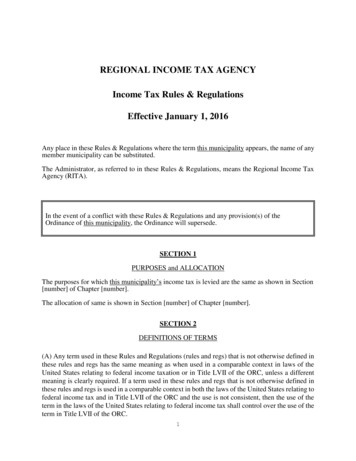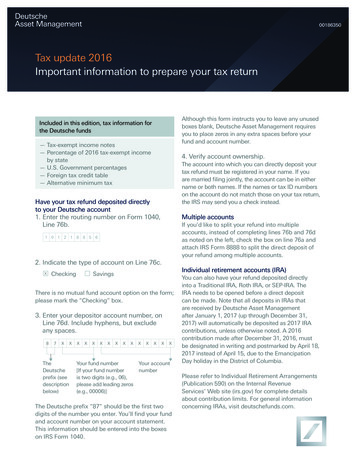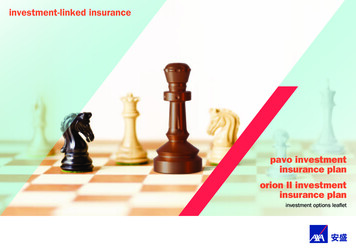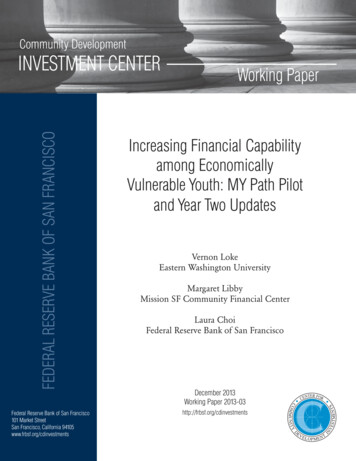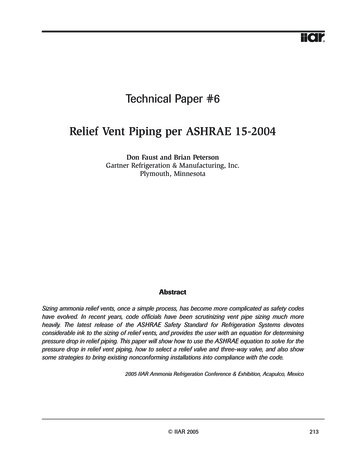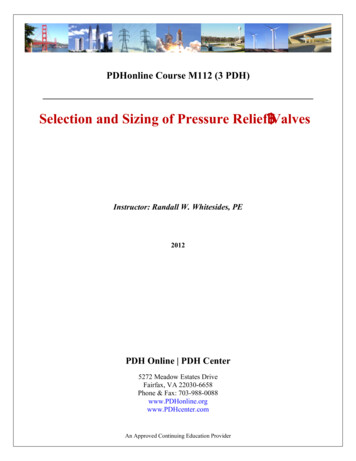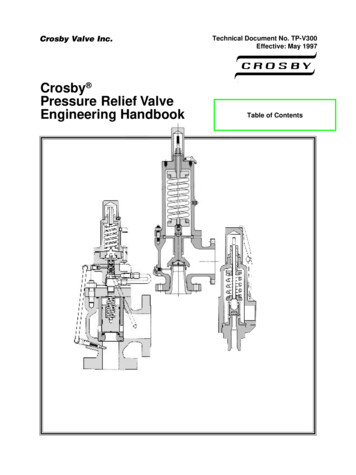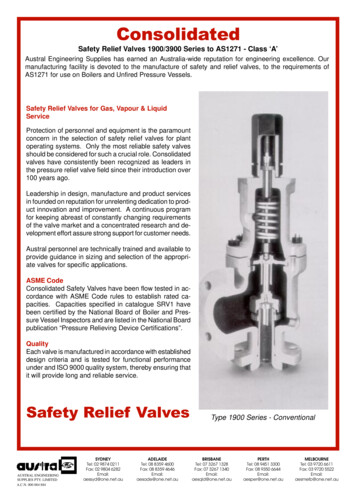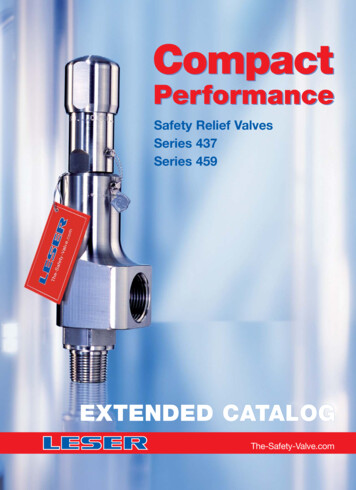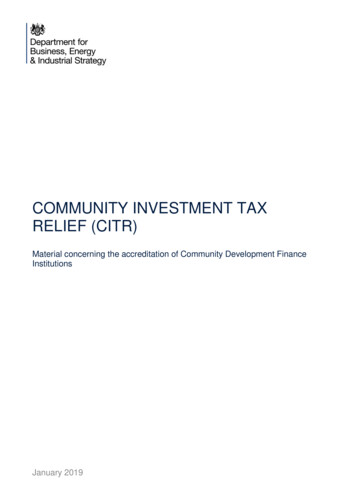
Transcription
COMMUNITY INVESTMENT TAXRELIEF (CITR)Material concerning the accreditation of Community Development FinanceInstitutionsJanuary 2019
Crown copyright 2019This publication is licensed under the terms of the Open Government Licence v3.0 except where otherwise stated.To view this licence, visit e/version/3 or write to theInformation Policy Team, The National Archives, Kew, London TW9 4DU, or email:psi@nationalarchives.gsi.gov.uk.Where we have identified any third-party copyright information you will need to obtain permission from thecopyright holders concerned.Any enquiries regarding this publication should be sent to us at:citr@beis.gov.ukCITR/19/1
ContentsPart 1: Introduction 5Context 5Part 2: Application and criteria for accreditation 6Criteria for accreditation 6Application process 7Notification of accreditation or refusal 7Renewal of Accreditation 8Part 3: Terms and conditions of accreditation 9Requirements to ensure retention of accreditation 9Distinction between retail and wholesale status 9State Aid de minimis 9Publication history: 10Annex A: Definitions of disadvantaged geographic areas 11Introduction 11England 11Scotland 11Wales 11Northern Ireland 11Annex B: Definition of residential property 12Residential property 12Annex C: Application form and guidance notes for community investment tax relief(CITR) accreditation 13Part 1: Summary information 13Part 2: Detailed discussion 15Part 3: Declaration 17Checklist and instructions for submission 173
Community Investment Tax Relief guidance note to support completion of application 18Part 1: Summary information 19PART 2: Detailed discussion 21Annex D: Annual reporting requirements for accredited community developmentfinance institutions (CDFIs) 24Narrative report 24Signed declaration 25Annex E: Community Investment Tax Relief (CITR) Annual Return 26Declaration 29Annex F: CITR Aid De Minimis requirements 30State Aid calculation 31State Aid letter wording 314
Community Investment Tax Relief (CITR) accreditation processPart 1: IntroductionContextThis material has the effect and purpose conferred by, and must be read in conjunction with,Part 7 Income Tax Act 2007 (for individual investors) or Part 7 Corporation Tax Act 2010 (forcompany investors) and the Community Investment Tax Relief (Accreditation of CommunityDevelopment Finance Institutions) Regulations 2013 as amended.5
Community Investment Tax Relief (CITR) accreditation processPart 2: Application and criteria foraccreditationCriteria for accreditationA body applying for accreditation as a Community Development Finance Institution (“CDFI”)must satisfy the following criteria:1. Be set-up with the intention of carrying on its activities for the long term, and for aminimum of five years, as demonstrated by:(a)the body’s chosen structure;(b)its funding and investment record or strategies;(c)its track record of existing operations as appropriate; and(d)other aspects of its business plan for the expected period of accreditation (forexample by projected income from operations contributing towards coveringadministrative costs).2.Intend, throughout the period for which it seeks accreditation, that not less than 75% ofthe activities and operations of the body are directed at the provision of finance, or theprovision of finance and access to business advice, for enterprises for disadvantagedcommunities (as described in paragraph 2e) below).3.Will only provide finance to enterprises that have been unable to obtain funding fromother sources, especially mainstream providers of finance, and will collect whateverinformation and apply whatever tests it considers appropriate as part of its loan makingprocess. It will offer a range of products applicable to the needs of its customer base.4.Will only provide finance to small or medium sized enterprises (SMEs) having:a) fewer than 250 employees;b) either an annual turnover which does not exceed 50 million Euro or an annualbalance sheet total which does not exceed 43 million Euro; andc) no more than 25% of their capital or voting control rights are controlled by anorganisation that is not itself an 1SME.1Some circumstances where an enterprise may be treated as an SME even if this 25%threshold is reached are set out in Commission Recommendation 2003/361/EC of 6th May2003.6
Community Investment Tax Relief (CITR) accreditation process5. Will only provide finance to those SMEs which meet at least one of the following criteria inrelation to disadvantaged communities:a) are located in a geographic area identified in Annex A (Case 1);orb) are located in an area not identified in Annex A but in which, by reference tomeasures of disadvantage relating to (Case 2):1. Income2. Employment3. Health, Deprivation and Disability4. Education, Skills and Training5. Geographical Access to Services,6. Housing, and7. Crimethere is a level of disadvantage comparable to that in the areas identified inAnnex A;orc) are owned and operated by, or intended to serve, individuals recognised as beingdisadvantaged on account of their ethnicity, gender, age, religious beliefs, disabilityor other defining characteristic (Case 3).Where finance is provided to SMEs that are eligible according to criterion 2, the body must alsobe providing at least an equivalent level of finance, measured in terms of transaction value andvolume, to SMEs that are eligible according to either criteria 1 or 3.6. Will not invest directly or indirectly in residential property as defined in Annex D.Application processApplications must be made in writing and must provide the information requested by theSecretary of State in Annex B. Applications for accreditation may be made at any time.Notification of accreditation or refusalNotification of accreditation or refusal will generally be made within two months of receipt of afully documented application in accordance with Annex C.7
Community Investment Tax Relief (CITR) accreditation processWhere a body has been refused accreditation, feedback will be provided on the main reason orreasons why the application was unsuccessful. If a body that has been refused accreditationbelieves that it is in a position to provide for consideration further information that addressesthe issues raised in the feedback it may do so. Such a body may also reapply at any time if itwishes to do so.Renewal of AccreditationCITR re-accreditation for a rolling period of 1 year will take place automatically (subject to theCDFI continuing to meet the conditions of accreditation) following successful receipt andapproval by BEIS of the CDFI’s annual return required before the expiry date of the currentaccreditation. The CDFI does not need to re-complete the application form in Annex B tobecome automatically re-accredited. Such automatic reaccreditation shall take effect from theday after the CDFI’s current period of accreditation was due to expire. If accreditation is nolonger required by the organisation, the organisation shall inform BEIS of this as part of theannual return.8
Community Investment Tax Relief (CITR) accreditation processPart 3: Terms and conditions ofaccreditationRequirements to ensure retention of accreditationContinued accreditation is conditional on the CDFI complying with Part 7 Income Tax Act 2007,Part 7 (Corporation Tax Act 2010) and the Community Investment Tax Relief (Accreditation ofCommunity Development Finance Institutions) Regulations 2013 as amended. Suchcompliance must be demonstrated through the provision of an annual report which must bemade in writing and provide the information requested by the Secretary of State in Annex D.Automatic re-accreditation of a CDFI shall only take place where the final annual report of aCDFI required before the expiry date of the current accreditation contains confirmation that theCDFI continues to meet the conditions for accreditation and that the CDFI wishes to apply forre-accreditation.Distinction between retail and wholesale statusNotification of accreditation will identify the accredited body as being either a retail orwholesale CDFI. In this context a retail CDFI is a body whose principal objective is to providefinance directly to eligible SMEs for their own business purposes, whereas a wholesale CDFI isa body whose principal objective is to provide finance for other accredited CDFIs.State Aid de minimis1.The Community Investment Tax Relief scheme is subject to State Aid de minimis rules.As a result it is the responsibility of the accredited CDFI to ensure no beneficiaryreceives aid which exceeds the limit of 200,000 over any three-year fiscal period.2.The CDFI must calculate the de minimis aid associated with each loan or investment. Inaddition the CDFI must also provide a letter to each party stating the levels of deminimis aid attributed to their investment or loan.3.In addition, it is the responsibility of a CDFI to ensure every successful loan applicant orpotential investment recipient is aware that they must declare any previous de minimisaid they have received during the fiscal year and the two previous fiscal years. If theCITR loan or investment would mean that the total de minimis aid exceeded 200,000then the aid cannot be granted under CITR. If it is subsequently discovered that aid hasbeen granted which causes the limit to be exceeded, then the recipient mustimmediately repay the loan or investment in full (with interest in some cases). If througha spot check, it is discovered that a CDFI has intentionally breached these limits thenthe accreditation may be withdrawn.The full detail regarding State Aid de minimis, including how to calculate the aid for allsuccessful loan applications and investment recipients and a template State Aid letter is laidout in Annex F.9
Community Investment Tax Relief (CITR) accreditation processPublication history:Version 1Version 2Version 3Version 4Version 5Published 15 January 2003Published 11 March 2008Published 1 April 2013Published 18 April 2017Published 31 January 201910
Community Investment Tax Relief (CITR) accreditation processAnnex A: Definitions of disadvantagedgeographic areasIntroductionMost CDFIs serve enterprises based or operating within a community that can be definedgeographically. Geographically based definitions of disadvantage may constructively beapplied in units from Lower Level Super Output Area (LSOA) level upwards. Because of thediffering administrative structures that exist in England, Scotland, Wales and Northern Ireland,the units of measurement and specific criteria used within the indices vary but the underlyingprinciples are the same in all cases. To determine the relevant LSOA or Local Authority inEngland or Wales please use the postcode lookup tool on the Office for National Statisticswebsite.Please note, for the purposes of defining a ‘qualifying investment’ the CDFI shouldrefer to the Indices of Deprivation current at the time the loan was made.EnglandThe English Indices of Deprivation operate at the level of Lower Layer Super Output Area(LSOA). Using these indices qualifying disadvantaged areas can be described geographicallyas being the top 35% most disadvantaged LSOA and the 82 Local Authority Districts appearingin the top 50 of any of the seven most recent Indices of Deprivation measures.ScotlandThe Scottish Index of Multiple Deprivation (SIMD) scores and ranks at datazone level. Usingthis data qualifying disadvantaged areas can be described as being the top 35% mostdisadvantaged.WalesThe Welsh Index of Multiple Deprivation is based on Lower Level Super Output Areas(LSOAs), with the top 35% most disadvantaged regarded as being qualifying disadvantagedareas.Northern IrelandThe Northern Ireland Multiple Deprivation Measure, is based on Super Output Areas (SOA).We determine that the top 35% most disadvantaged are regarded as being qualifyingdisadvantaged areas.11
Community Investment Tax Relief (CITR) accreditation processAnnex B: Definition of residential propertyThe following specific definitions apply to the use of an accredited CDFI’s investment fund inconnection with property (you should refer to Schedule 1, Paragraph 8 of the Regulations fordetails of property investments which are not relevant investment
Community Investment Tax Relief (CITR) accreditation process 6 Part 2: Application and criteria for accreditation Criteria for accreditation A body applying for accreditation as a Community Development Finance Institution (“CDFI”) must satisfy the following criteria: 1. Be set-up with the intention of carrying on its activities for the long term, and for a
